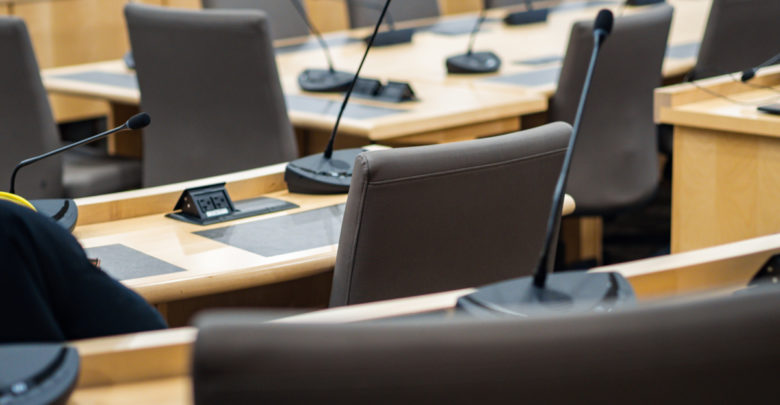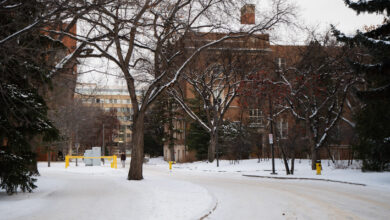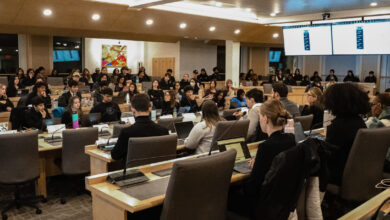SEAP annual report presented to GFC
The SEAP team will focus on academic advising in the upcoming academic year.
 Helen Zhang
Helen ZhangAt the March 31 meeting of the University of Alberta’s General Faculties Council (GFC), the motion to approve the three-year review of the GFC Committee on Documentation of Indigeneity (CDI) terms of reference passed. Additionally, the Student Experience Action Plan (SEAP) annual report was presented.
In his opening comments, President and Vice-chancellor Bill Flanagan discussed the exemption to the post-secondary sector under the Provincial Priorities Act. This exemption means that the U of A will not have to secure prior approval from the province before implementing changes to existing and new agreements with the federal government.
“This was a matter of great importance to the university and our researchers,” Flanagan said. “It was an intensive process of advocacy over quite a period of time, working closely with our colleagues in the post-secondary sector.”
GFC CDI renamed
The motion to approve the three-year review of the CDI terms of reference passed. With this motion, CDI has been renamed to the GFC Committee on the Documentation of First Nations, Metis, and Inuit Identity.
“The committee has made the decision to move from Indigenous to First Nations, Metis, and Inuit because this helps to clarify the committee’s work,” faculty of arts representative Lise Gotell said.
Layla Alhussainy, U of A Students’ Union (UASU) vice-president (academic), asked how these changes will impact documentation verification for Indigenous students who are non-status. Chris Andersen, dean of the faculty of Native studies, said that this will have “no impact” on how the university will look at non-status Indigenous applicants.
Faculty of medicine and dentistry representative Peter Senior asked if there was “consideration about the capacity of the communities” this committee seeks to represent. Melissa Padfield, deputy provost (students and enrolment), said that “moving to term limits helped to acknowledge individuals’ contribution and capacity.”
Additionally, the motion to approve the GFC governance framework passed.
SEAP annual report presented
Padfield and Sarah Wolgemuth, associate vice-president (student experience), presented the SEAP annual report. According to Wolgemuth, 28 of SEAP’s 30 initiatives are either on track or completed. This progress includes the addition of over 60 all-gender washrooms on North Campus and the launch of the Black Youth for Social Innovation program, Padfield said. Progress on SEAP in 2024–25 will be collected in fall 2025.
Academic advising will be a key focus of the plan in upcoming months. Moving into 2026, the SEAP team will begin to develop “SEAP 2.0,” Wolgemuth said.
Christine Hughes, dean of the faculty of pharmacy and pharmaceutical sciences, asked how SEAP’s student advising project differentiates between general and professional programs. Padfield said that student demand for both academic and non-academic advising came out of the SEAP survey. This advising project will have navigational, academic, and support components, Padfield said.
The SEAP team hosted a student summit on academic advising and plans to host another. An advisory committee of student service advisors will be developed to guide engagement with student service professionals. Based on this work, a series of recommendations will be developed by December 2025, Padfield said.
GFC discusses draft Space Management Policy
Additionally, the draft Space Management Policy was discussed. The revised policy is aimed at “enabl[ing] the university to drive space optimization efforts to support the projected growth,” Todd Gilchrist, vice-president (university services, operations, and finance), said.
Related to the policy, the Board of Governors (BoG) approved Built for Purpose: The University’s Strategic Campus Plan at its March 28 meeting. Consultation on the revised policy is ongoing, Gilchrist said.
The revised policy includes a territorial acknowledgment “due to the importance of the relationship between property, space use, and the land,” Ashley Bhatia, associate vice-president (infrastructure planning, development, and partnerships), said.
Alhussainy asked how the restructuring process for external entities will impact student groups such as faculty associations. Bhatia said that her team is working with the Dean of Students (DoS) Office “to streamline some of the student group accesses to space on campus.”
Logan West, undergraduate faculty of arts representative, raised concern with student consultation with the policy and asked if student spaces will remain a priority. Bhatia said that her team reached out to the Graduate Students’ Association (GSA) and UASU presidents, but the representatives assigned to the project “were more the administrative representatives.” She added that her team would be “absolutely willing to swap in the elected representatives at any time.”




